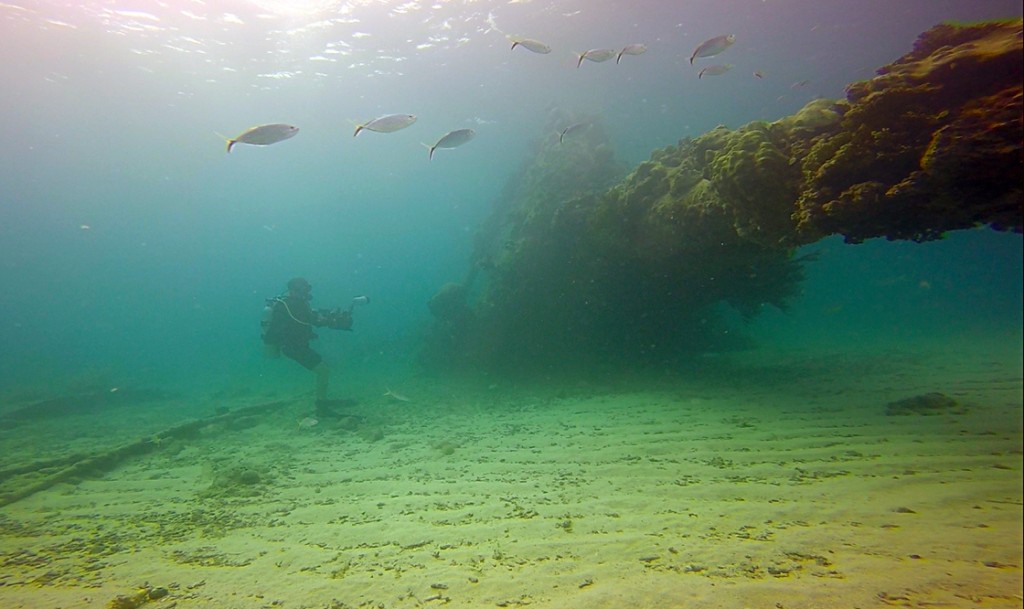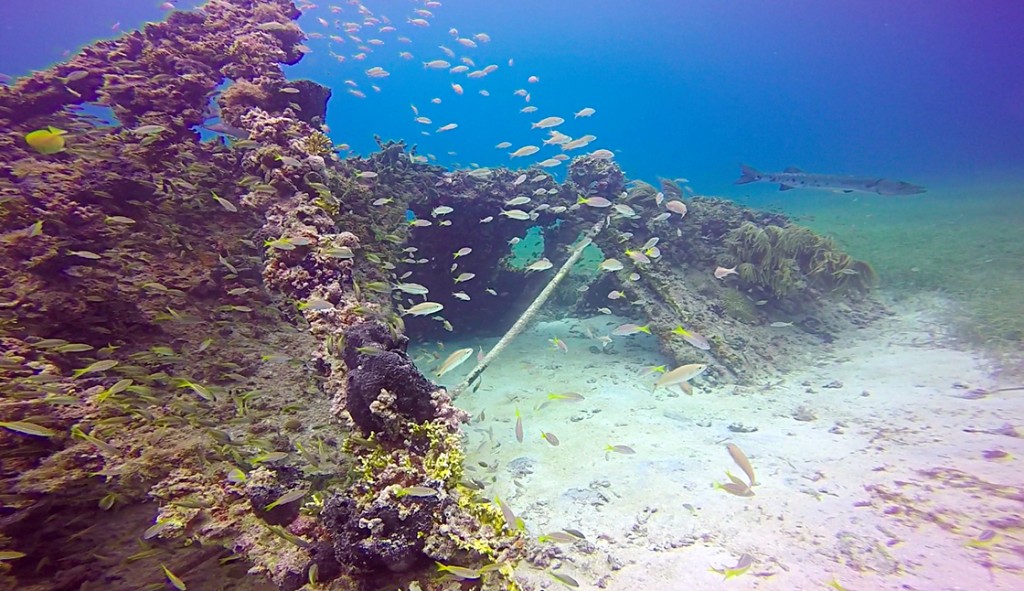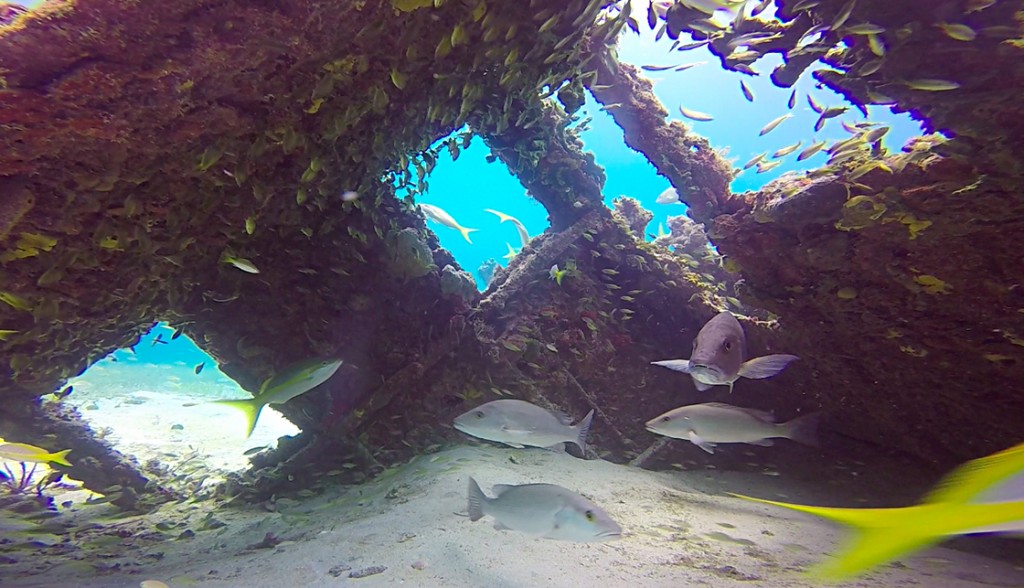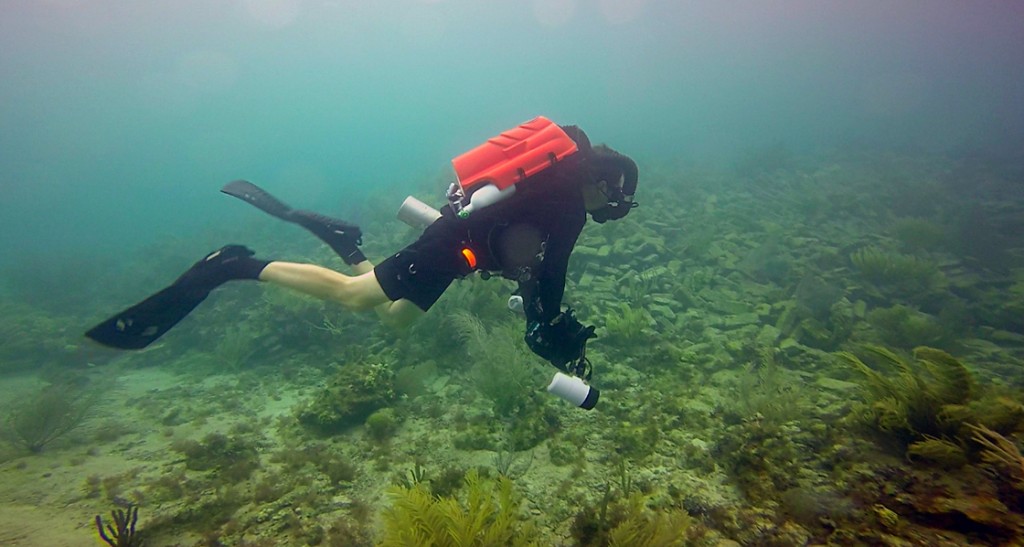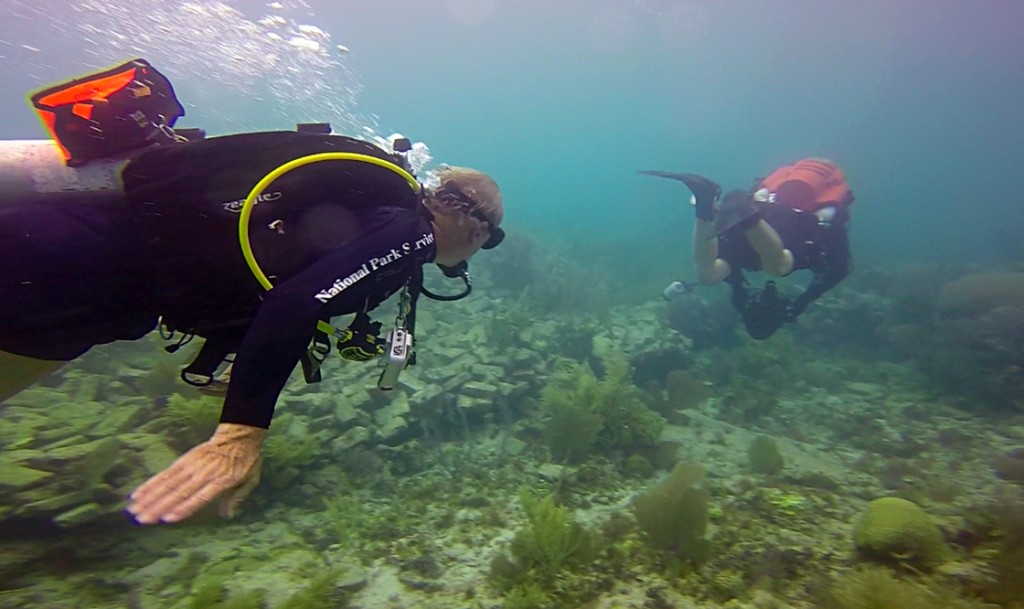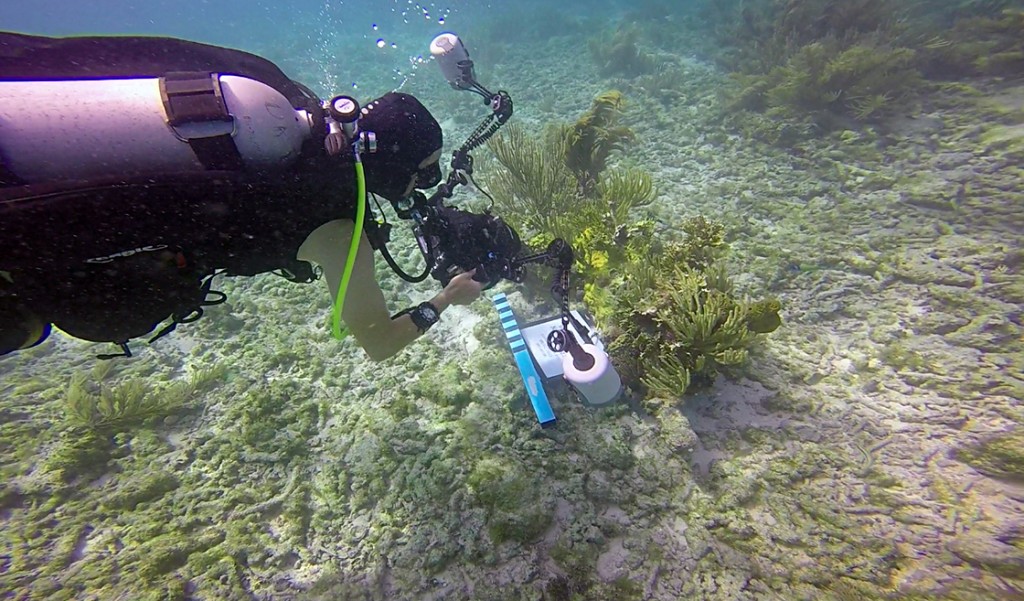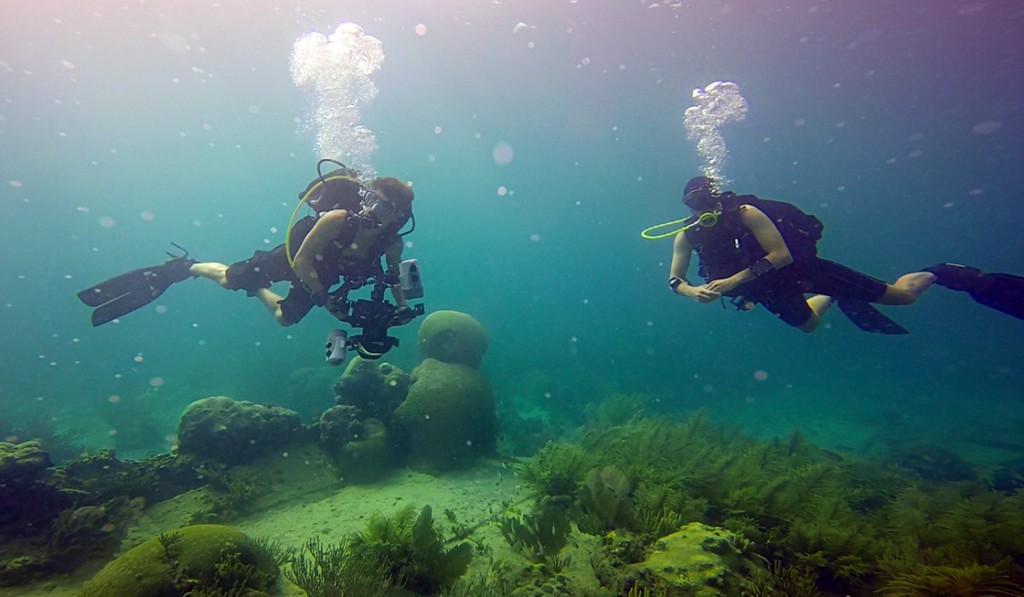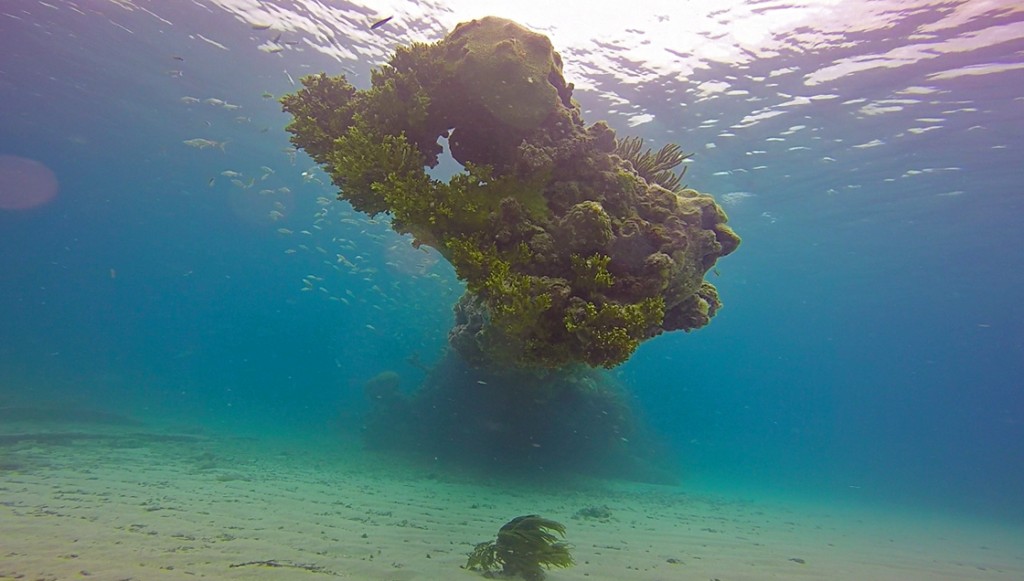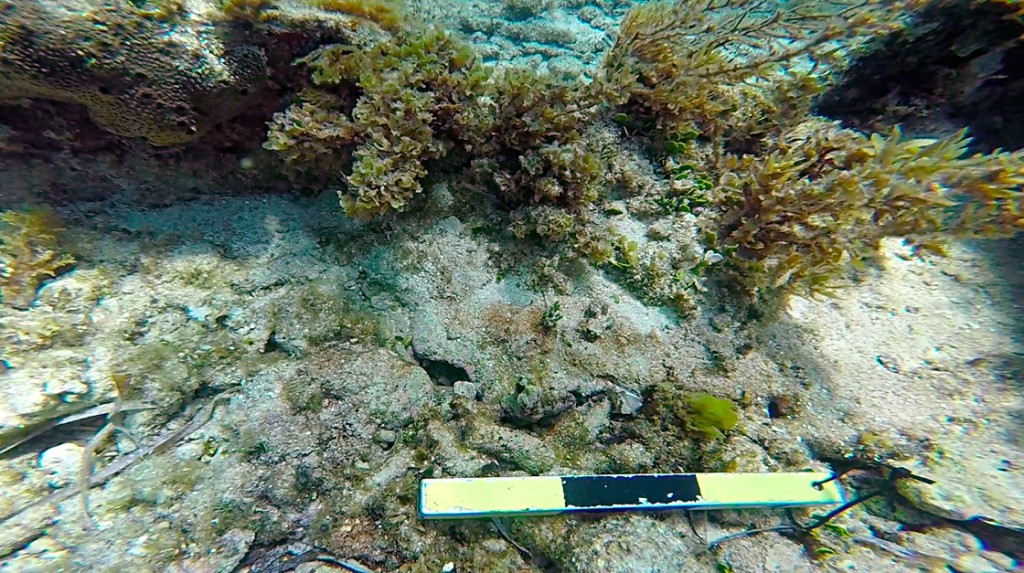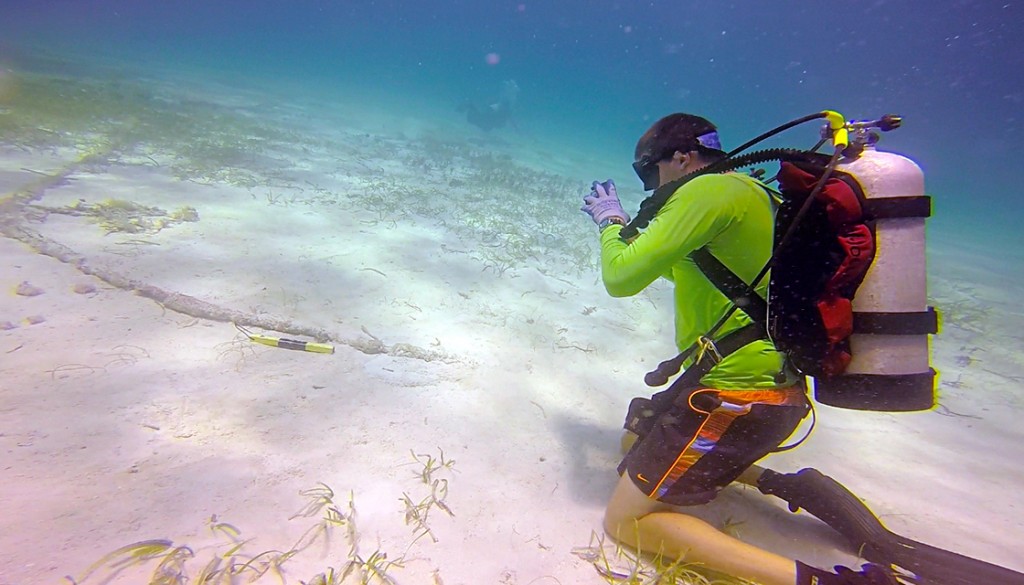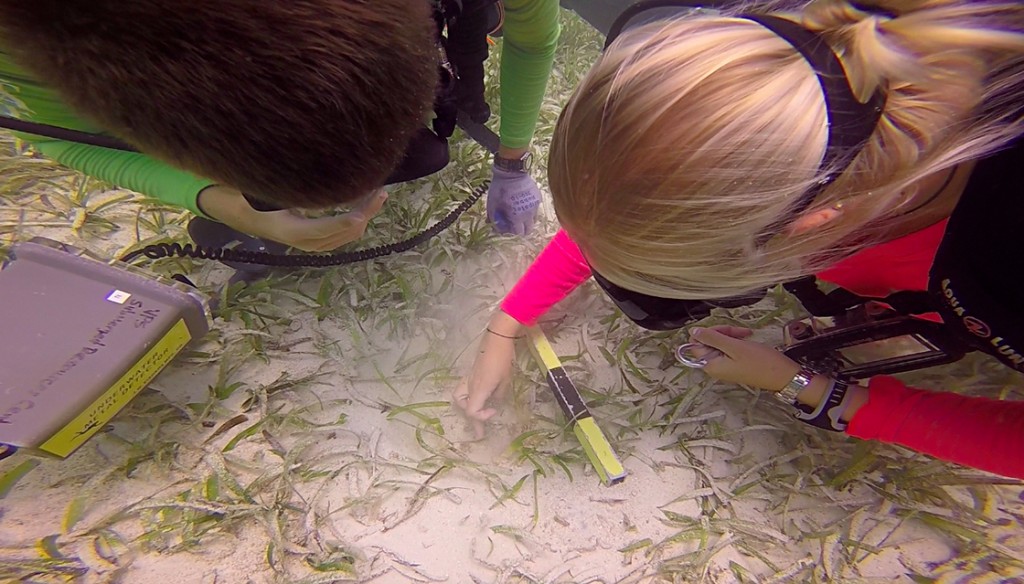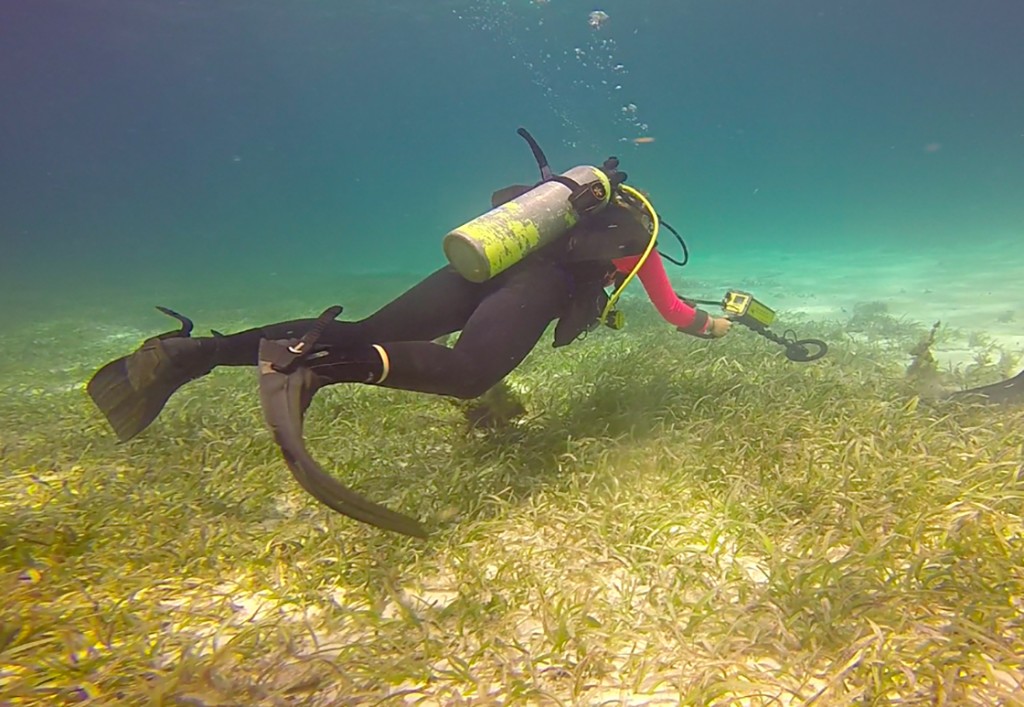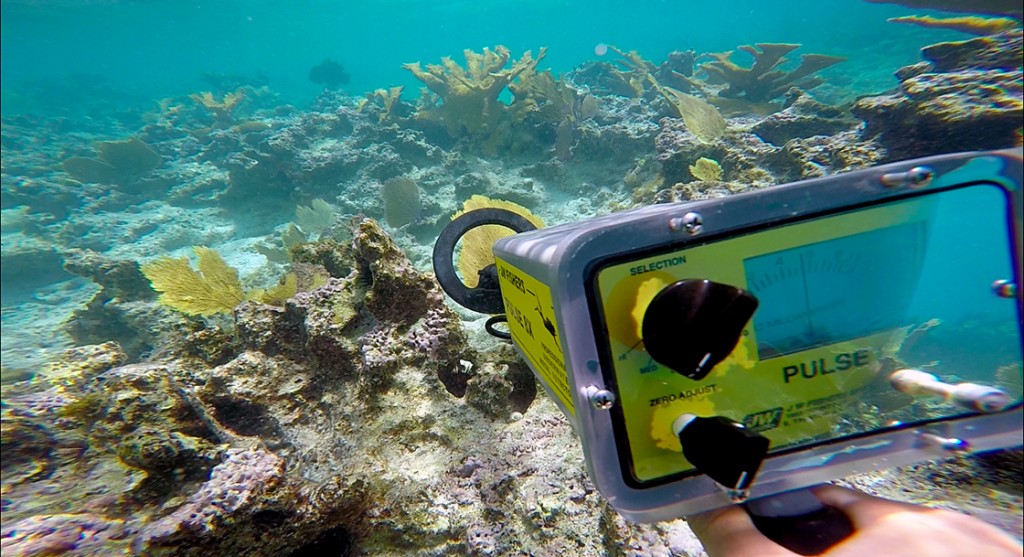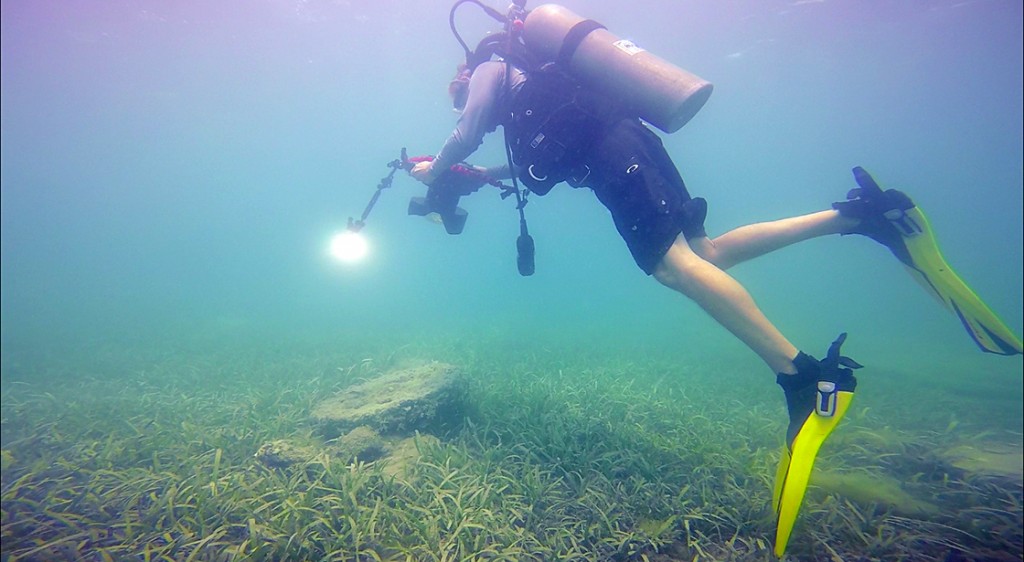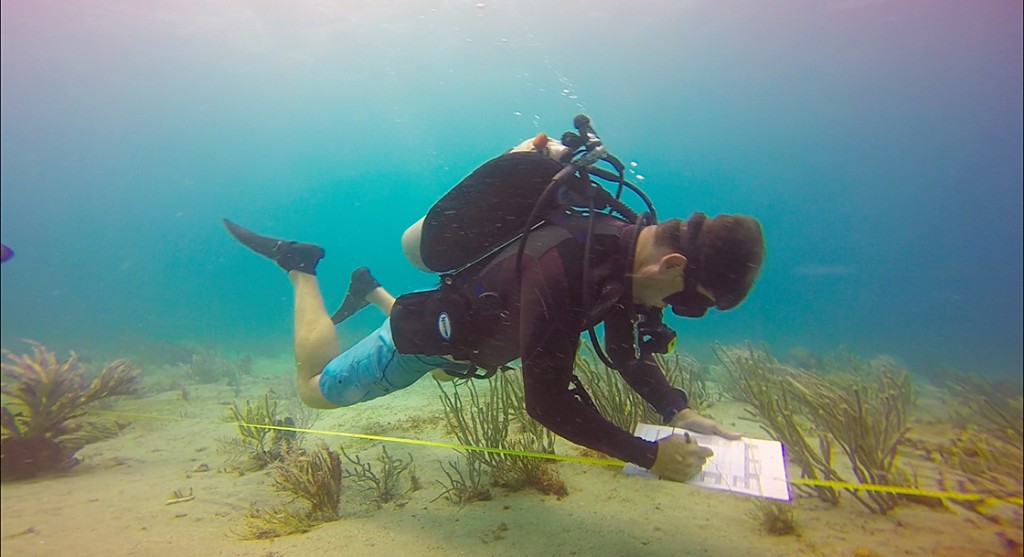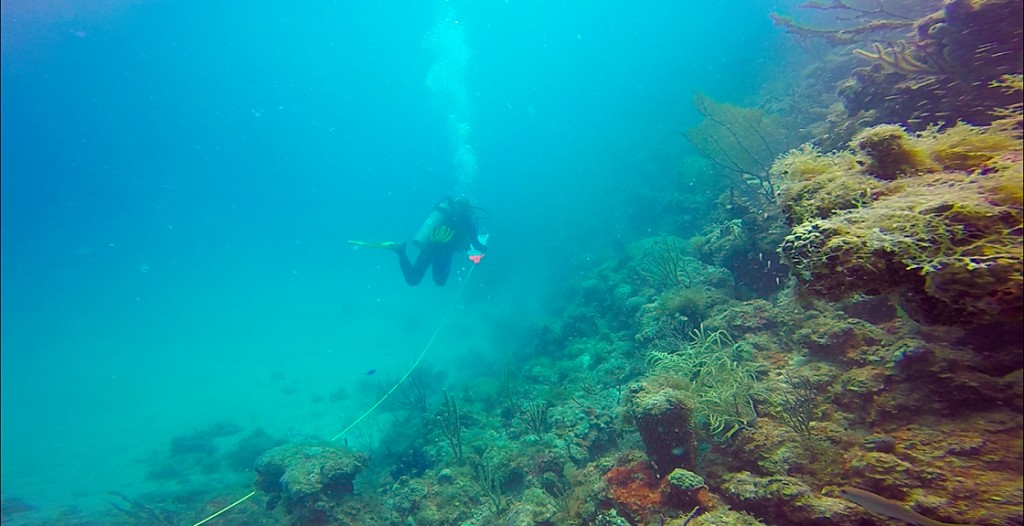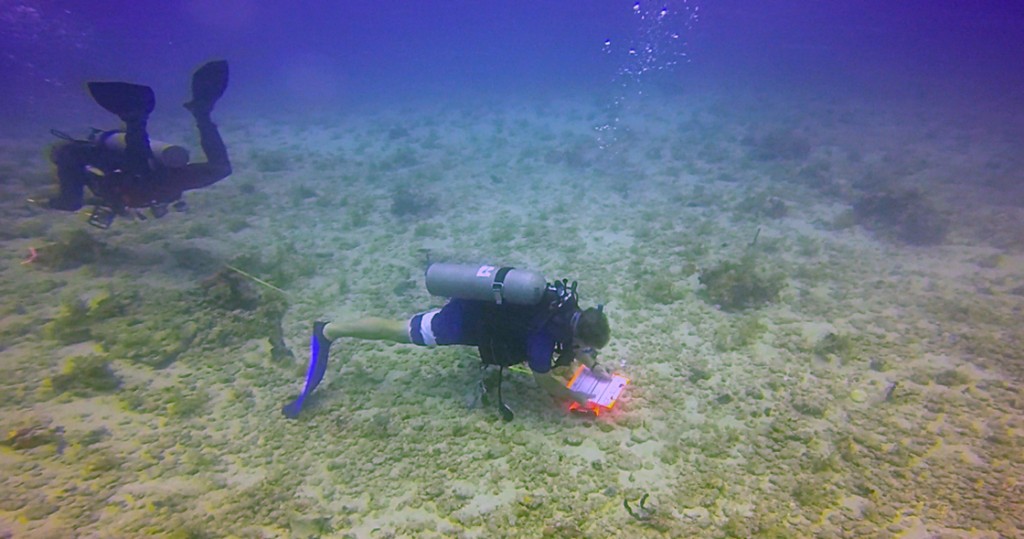PRESENTATION BY DR. JOE MACINNIS AT THE 0WUSS 42ND ANNUAL AWARDS PROGRAM
CLIMATE CHANGE: Anyone Can Change Everything
Dr. Joe MacInnis
Our World-Underwater Scholarship Society®
42nd Annual Awards Program
New York Yacht Club
April 16, 2016
IT’S AN HONOUR to be in your company. Each one of you from Rolex Scholar to intern, from
supporter to sponsor, confirm what can be done when good people do small things with great love.
A month ago, Jim Corry and Lionel Schürch of Rolex SA in Geneva asked me to talk to you for ten minutes about climate change. My heart sank. How do you describe the planet’s most pressing environmental problem—a biological crime scene—and our response to it—in 600 seconds? Faced with the possibility of certain defeat on this stage, I did what any ancient diver would do. I sat down and opened a bottle of black rum.
As the days passed and my anxiety increased, I kept thinking of the words from the Rolex Spirit of Enterprise mission statement: “Anyone can change everything.” An electric call to action. “Anyone can change everything.” But, for the life of me, I couldn’t figure out how to use the words in my speech.
Two weeks ago, I’m in a service station filling my Toyota Prius. I put my credit card into the slot and look at all the cars and trucks. Black Cadillac. Ford Fusion. Big Hummer. An 18-wheeler sucking up diesel fuel. This is a front-line of climate change. This is where energy-intense carbon molecules really hit the road.
I ease the nozzle into my gas tank. During my lifetime, I’ve done this more than a thousand times. When you factor in all the ships, trains, and planes I’ve taken, I’m a poster boy for global warming. On the plus side, I’m a nation builder. My fossil fuel payments support the Kingdom of Saudi Arabia.
As the gas runs into the tank, my mind drifts to New York, this stage, and the speech I can’t write. I think of rising sea levels in Manhattan. There will be water taxis on Wall Street. Wind surfing on Park Avenue. At the New York City Yacht Club, you’ll go to the front door, walk out on a pier, and hail a yellow gondola.
I look at the cash window on the gas pump: $10 . . . $12 . . . $15. I’m more than a poster boy for climate change, I’m a carbon addict. Every day, in one form or another, I mainline diesel fuel, jet fuel, natural gas, and plastics. For years, I thought ExxonMobil and Volkswagen were ethical companies. I know I need help.
I pick up my receipt, slide behind the wheel, and drive off. The good news is that I’m in rehab. I have weekly sessions with my fellow addicts. We tell stories of binging on tail-pipe emissions at the Indy 500. People we know buying mega-stretch Hummers with a helicopter pad. But we exchange encouraging information. How 150 nations came together in Paris to sign a climate change agreement. How cities from New York to San Francisco to Toronto are shifting to green energy. How inspiring institutions and individuals including World Wild Life, Greenpeace, Bill McKibben, Naomi Klein, and Justin Gillis are showing us what we can do.
My rehab assignment this week is to produce a short guide about climate change, and how we can adapt to it. With Rolex’s assistance, we have printed copies for each of you. Please read it. Absorb it. Pass it along. Take action. And remember . . . When it comes to minimizing the effects of climate change…with leadership and passion, “anyone can change everything.” Thank you, Jim and Lionel. It’s been a pleasure speaking to you. Justin Gillis Article
PROGRAM BOOK: 42ND ANNUAL AWARDS PROGRAM
PRESENTATION BY DR. JOE MACINNIS AT THE 0WUSS 42ND ANNUAL AWARDS PROGRAM
CLIMATE CHANGE: Anyone Can Change Everything
Dr. Joe MacInnis
Our World-Underwater Scholarship Society®
42nd Annual Awards Program
New York Yacht Club
April 16, 2016
IT’S AN HONOUR to be in your company. Each one of you from Rolex Scholar to intern, from supporter to sponsor, confirm what can be done when good people do small things with great love.
A month ago, Jim Corry and Lionel Schürch of Rolex SA in Geneva asked me to talk to you for ten minutes about climate change. My heart sank. How do you describe the planet’s most pressing environmental problem—a biological crime scene—and our response to it—in 600 seconds? Faced with the possibility of certain defeat on this stage, I did what any ancient diver would do. I sat down and opened a bottle of black rum.
As the days passed and my anxiety increased, I kept thinking of the words from the Rolex Spirit of Enterprise mission statement: “Anyone can change everything.” An electric call to action. “Anyone can change everything.” But, for the life of me, I couldn’t figure out how to use the words in my speech.
Two weeks ago, I’m in a service station filling my Toyota Prius. I put my credit card into the slot and look at all the cars and trucks. Black Cadillac. Ford Fusion. Big Hummer. An 18-wheeler sucking up diesel fuel. This is a front-line of climate change. This is where energy-intense carbon molecules really hit the road.
I ease the nozzle into my gas tank. During my lifetime, I’ve done this more than a thousand times. When you factor in all the ships, trains, and planes I’ve taken, I’m a poster boy for global warming. On the plus side, I’m a nation builder. My fossil fuel payments support the Kingdom of Saudi Arabia.
As the gas runs into the tank, my mind drifts to New York, this stage, and the speech I can’t write. I think of rising sea levels in Manhattan. There will be water taxis on Wall Street. Wind surfing on Park Avenue. At the New York City Yacht Club, you’ll go to the front door, walk out on a pier, and hail a yellow gondola.
I look at the cash window on the gas pump: $10 . . . $12 . . . $15. I’m more than a poster boy for climate change, I’m a carbon addict. Every day, in one form or another, I mainline diesel fuel, jet fuel, natural gas, and plastics. For years, I thought ExxonMobil and Volkswagen were ethical companies. I know I need help.
I pick up my receipt, slide behind the wheel, and drive off. The good news is that I’m in rehab. I have weekly sessions with my fellow addicts. We tell stories of binging on tail-pipe emissions at the Indy 500. People we know buying mega-stretch Hummers with a helicopter pad. But we exchange encouraging information. How 150 nations came together in Paris to sign a climate change agreement. How cities from New York to San Francisco to Toronto are shifting to green energy. How inspiring institutions and individuals including World Wild Life, Greenpeace, Bill McKibben, Naomi Klein, and Justin Gillis are showing us what we can do.
My rehab assignment this week is to produce a short guide about climate change, and how we can adapt to it. With Rolex’s assistance, we have printed copies for each of you. Please read it. Absorb it. Pass it along. Take action. And remember . . . When it comes to minimizing the effects of climate change…with leadership and passion, “anyone can change everything.” Thank you, Jim and Lionel. It’s been a pleasure speaking to you.
2016 North American summer internships Announcement
Founded in 1975, OWUSS has sponsored 94 experience-based Rolex scholarships and 93 internships to young people who want to pursue careers in fields such as marine biology, underwater research, and conservation. The society offers summer internships in North America for 1-3 month periods to college undergraduates and recent graduates. Internship recipients receive an educational grant to help fund travel to/from internship site, room and board, and a stipend to cover living expenses. The sponsor organizations that host the internships are leaders in their fields.
George Wozencraft, Vice President Internships, says “This year’s selection process was competitive, with many qualified applicants. In addition to those selected for the 2016 internships, I want to commend the finalists for each internship. We thank the members of our internship selection committee for their contribution. Additionally, we appreciate our internship sponsors and coordinators for the tremendous support that they provide to our volunteer organization.”
Here are the 2016 internships and recipients:
Dr. Lee H. Somers American Academy of Underwater Science (AAUS) Scientific Research Diving Internship
Allie D. Sifrit, University of Hawaii at Manoa
This internship provides experience for a young person interested in a future in science, diving for research, or scientific diving-related fields. Intern applicants can be students from colleges and universities with an interest in science and diving. The program runs from mid-May through August and will include training at one of several AAUS organizational member sites. This training will give the intern the necessary dive qualifications to allow participation on research projects requiring scientific diving and introduce the intern to careers that utilize scientific diving as a tool. Once trained as an AAUS recognized diver-in-training, interns will participate in underwater fieldwork at one or more locations and research facilities associated with AAUS.
This internship is named in memory of Dr. Lee H. Somers, who was AAUS’ first President and served as a long time officer and board member of OWUSS.
Bonnier Dive Group Publishing Internship
Melissa J. Smith, University of Florida
Based in Winter Park, Florida, the recipient of this internship will gain valuable real world experience in magazine publishing. Bonnier Corporation is one of the largest consumer- publishing groups in America, with nearly 50 special-interest magazines and related multimedia projects and events. The Bonnier Dive Group includes “Sport Diver,” “Scuba Diving,” and “Undersea Journal.” The intern will have the opportunity to contribute to these and other Bonnier Corporation publications.
National Park Service Research Internship
Garrett J. Fundakowski, Shippensburg University
The National Park Service Research Internship provides a unique opportunity to work with leading archaeologists, underwater photographers, and scientists in the National Park Service and other agencies in the American state and federal government. Specific work projects will be determined based upon the interests of the intern as well as the needs of associated projects. The internship is based in Boulder, Colorado, but it is expected that the intern will travel to projects within the continental United States and potentially overseas as part of this internship. Experiences could involve a specific project in a single park or a larger project in multiple parks.
The Reef Environmental Education Foundation (REEF) Marine Conservation Internship
Patrick M. Peck, University of Richmond
Offered in Key Largo, Florida, the Marine Conservation Internship provides an opportunity to experience working at a nonprofit environmental organization. REEF is a grassroots, non-profit organization of recreational divers dedicated to protecting and preserving the underwater environment. Outside duties include environmental presentations to local and visiting schools, university, dive, and public groups; working with other local marine conservation entities; and opportunities for conducting marine life surveys during local dives. Office duties include handling memberships, incoming marine life survey data, answering e-mail, and dealing with the public.
For more information about the Our World-Underwater Scholarship Society, please visit our website: http://www.owuscholarship.org.
For the official press release: 2016_OWUSS_Internship_Press_Release_March_2016.
Wind, Waves and Wrecks in the Dry Tortugas
After a long car ride from Biscayne National Park to Key West on a rainy Saturday in late July, Brett Seymour and I met up with the m/v Fort Jefferson, the Dry Tortugas National Park (DRTO) support and research vessel. Aboard the Fort Jefferson was Dave Conlin, who had just returned from 3 weeks in the DRTO. Unfortunately we had to say goodbye to Dave the next morning. The Fort Jefferson was set to depart in the morning on July 27th, so we had just one day to gather all the groceries we would need to resupply the rest of the SRC staff out at DRTO for the next 3 weeks.

It’s hard to tell in this image, but just the groceries alone took up the massive bed of the SRC’s truck. That’s a lot of food – despite what kind of boxes the grocery store gave us.

The Fort Jefferson, DRTO’s support vessel. DRTO relies on the Ft. Jeff to bring in supplies like food, gasoline and diesel from Key West.
After meeting up with legendary archeologists Jim Bradford and Volunteer Extraordinaire Jim Koza, we took an entire day to gather all of our supplies and to double check that we had everything we would need to live in the remote reaches of Garden Key for the next 3 weeks. Key West is the furthest south you can drive on the East Coast, and in order to get to DRTO you either need to take a boat or a seaplane 70 miles to the west into the Gulf of Mexico. Throughout the summer I had heard many rumors and tails of DRTO, and I was very much looking forward to visiting the historic Fort Jefferson (the actual fort on Garden Key). DRTO is my last expedition for the summer, and I fully planned to make the most of it.
Ever since the Europeans colonized North America, the Dry Tortugas have been an incredibly important piece of maritime history. Sitting at the confluence of the Gulf of Mexico and the Atlantic Ocean, shipping traffic to and from the Gulf had to pass through the Tortugas, or swing far to the south and east. Because of the shifting keys, ever changing winds and shallow coral reefs, the Tortugas are home to an incredible wealth of cultural resources, mainly shipwrecks. In 1846 the United States started the construction of a hexagonal fort on Garden Key; some 16 million bricks make up the stunning Fort Jefferson. Though the fort was never technically completed, it still stands as a testament to military construction and ingenuity. Not to mention master masonry.

A little insight into a day in the life at Crew’s Quarter. Clockwise from top: Bert’s message board detailing the day’s activities, chore schedule and the dinner menu; the bunkroom, with complimentary plastic canopies to keep ceiling debris from falling on you; Bert at the all purpose dining table/work bench mapping a site; Koza pauses briefly after working on a detailed site map.
During our stay at DRTO we lived within the walls of the fort, in a casemate retrofitted with a kitchen, dorm room style bunks, a bathroom and even air conditioning. A luxury that the men and women stationed at the fort never enjoyed. 9 of the project staff would call the Crew’s Quarters home, while the others stayed in the Engineer’s apartments, or on the Fort Jefferson. The majority of the Submerged Resources Center was present at the fort, mounting a large maritime archeology inventory and documentation. It was great to be reunited with them after having spent the summer traveling across the Park Service.
DRTO works with a skeleton crew; mainly a few biotechs and cultural resource staff, law enforcement rangers that rotate on and off the island and a couple maintenance personnel which are responsible for keeping everything running. The bulk of the island’s population are the visitors to Garden Key that arrive and depart on the daily ferry from Key West. Though a few campers occasionally spend the night in the campground in front of the fort. With little running water and electricity, and almost no Internet, (for staff only) DRTO is considered one of the Park Service’s best-kept secrets. I knew I would fall in love with this place even before I arrived, but I wasn’t prepared for what I saw once the Fort Jefferson was tied up at her dock. The fort looms over a moat, connected to the rest of the key via a wooden bridge that takes visitors through the sally port, under the walls of the fort and into the parade ground. Stepping into the fort is like stepping into a medieval castle. This place would be my home for the next two weeks, and already I was bustling with excitement.
The next day I jumped on the survey boat with a few of the crew from the SRC. This is how anomalies are found, by towing a magnetometer behind a boat. Whenever the mag picks up a pulse, its position is marked on a map. Eventually we would get to jump some of the anomalies we picked up when “towing the fish”.

Volunteer Dylan Hardenberg and I prepare to launch the magnetometer off of the back of the SRC’s research vessel Cal Cummings. Photo credit to Susanna Pershern
The crews already out at DRTO had been there for some 3 weeks, and were more than happy to welcome new faces to their group. After a day of mag surveys, the last for the summer, I spent my days either jumping anomalies or helping out with some of the photo-documentation work Brett Seymour and Susanna Pershern, the SRC’s other photographer, were working on. In between photographing new sites, and some of the sites from previous surveys, Brett has been working on a new 3D photogrammetry technique for mapping sites. By swimming in a spiral around a fixed object, like a shipwreck, and taking pictures in a continuous stream, Brett generated 100% optical coverage of the object. After uploading the images into special software, sometimes more than a 1000 images, he is able to generate an interactive 3D image. It takes a lot of work, and a lot of swimming, but the models Brett is able to generate have huge implications for the future of cultural resource management and interpretation.

It would appear as though fish aren’t the only organisms attracted to DRTO’s cultural resources. Photo credit to Brett Seymour
- In order to generate a 3D image of an object, like this wrecked shrimp boat, Brett must swim in a continuous ark while taking hundreds of pictures in sequence. The images are then uploaded into complex software that compiles everything into a 3D model.
- Brett takes a minute to admire the bow and prow of one of DRTO’s most famous wrecks, the Windjammer
- This mean-looking fish gracefully let us document his wreck. It’s hard to tell, but he as probably about 5ft long!
- Looking inside the VJ, it’s not hard to believe that DRTO’s waters are absolutely teeming with fish. The Park provides a rare refuge for commercially desirable fish like these snapper.
- The SRC never travels lite. Most of the crew at DRTO had brought down their rebreathers for a little bit of practice. Setting up field ops for CCRs isn’t easy, but that’s just a part of another day’s work for the SRC.
- Volunteer Extrondinare Jim Koza accompanies Brett as he swims around a site for his photo-mosaic 3D mapping project.

Brett Seymour prepares for another dive documenting some of DRTO’s cultural resources while archeologist Jim Koza waits in the warm water.
Of course, while jumping anomalies and investigating shipwrecks, I couldn’t help but notice the abundance of flora and fauna covering the reefs of DRTO. Because of the Dry Tortugas’ remoteness, many large fish species that are absent or rare in the Florida Keys are thriving in the Park Service’s protected waters. Once commercially important fish, like goliath groupers, are all but gone from the Keys. But 4 or 5 of these monstrous fish lurk just under the dock where the Fort Jefferson ties up. And all of the intact shipwrecks we visited provide important habitat and structure for reef dwelling organisms. The natural resources of these waters are partially what attracted what are now considered cultural resources. And these cultural resources now attract said natural resources.
- Susanna snaps a photograph of a swivel gun, covered in algae and coral.
- One of the most exciting days I had at DRTO was spent jumping anomalies with SEAC archeologist David Morgan. As we rolled off the dive boat we immediately found ourselves descending onto a previously undiscovered shipwreck.
- While I accompanied Brett during one of his mapping dives, Susanna and Dylan were documenting some other parts of the Windjammer. Susanna is an incredible photographer, and I learned a lot from just watching her and Brett.
- Another look at the Windjammer’s prow. The dive conditions at DRTO were absolutely incredible.
Due to DRTO’s remoteness, and the schedule we stuck to, it was easy to fall into a comfortable rhythm. After that first day on the survey boat, we pretty much spent every day after in the water surveying sites, jumping anomalies and documenting artifacts. Aside from being blown out by weather a couple of times, we were far from dry in the Dry Tortugas.
In between working with the archeologists, I was also able to squeeze in some time with the natural resource team. I walked the beaches of the remote East Key looking at turtle nesting sites, and even went on a night dive with a team looking at coral spawning events. With all the beauty of DRTO above and below the water, there wasn’t any time to be bored. It was honestly refreshing to live without certain modern obligations, like the Internet and cell phones. Though I was very appreciative to have air conditioning in our living quarters. Fort Jefferson is essentially a gigantic brick oven; “dry days” inside the fort were almost unbearable.
Although the teams were split between the two dive boats during the day, we all gathered in the evenings for a communal meal. Brett Seymour’s wife, Elizabeth, prepared dinner for the 13 of us every night, and I know everyone was incredibly appreciative. In order to keep things harmonious, everyone was assigned to a daily chore rotation. After a day of diving under the hot tropical sun, sweeping the floor or filling scuba cylinders wasn’t too bad if that was all you had to do.
All in all DRTO was more than I could have ever hoped for. Working and living with such a dedicated team of professionals was an incredible learning experience. And the memories I have from living in the fort, and from this entire summer, will stick with me for a long time. I’d really like to thank everyone from the SRC and SEAC for putting up with me during those two weeks. And even though my background is in marine biology, not maritime archeology, I learned more than I thought I could about cultural resources.

The members of expedition DRTO-SRC-0188 gather in front of Fort Jefferson’s welcome sign. From left to right: Dylan Hardenberg, David Morgan, Jeneva Wright, Susanna Pershern, Jess Keller, Charlie Sproul, Bert Ho, Koza, Jim Bradford, Brett Seymour, Elizabeth Seymour, and Cameron and Chase Seymour.
As I watched the sun set from atop the three story fort, I reflected on my experiences this summer. After a quick seaplane flight back to Key West, I’m off to give my final report in Washington D.C. Looks like I’ll be trading out a wetsuit for something a little more formal.
Thanks for reading.

I have to admit, DRTO made me more than a little trigger-happy. Everywhere you look, any time of day, there was something to catch the eye.
Biscayne National Park Part 3: Jumping Magnetic Anomalies

On some days we jumped up to 6 anomalies; the backwards roll is the preferred method of watery entry off of the Park Service’s boats.
After 2 eventful weeks in the USVI, I found myself back in South Florida at Biscayne National Park. It might sound odd, returning to BISC felt like the closest thing to coming home. Although this has been an experience of a lifetime, as soon as I feel acquainted with a particular Park, I’m already off to somewhere new. After bouncing from Park to Park all summer, it was good to see some familiar faces.
With so many different projects going on at BISC it wasn’t hard for me to find a way to be useful. Because I had already spent my previous two weeks at BISC working with natural resources, I decided to try my hand at exploring some of the Park’s cultural resources. As it happens, one of the interns I was staying with, Maddie Roth, would be “jumping anomalies” all week with an undergraduate volunteer from a local University. I figured I would lend a hand to see if I couldn’t learn a thing or two.

Often times the weather in the South Atlantic can turn without a moment’s notice. It wasn’t uncommon for a squall to blow through, leaving calm water and sunny skies in its wake.
Because of Biscayne Bay’s rich maritime history, and potential navigation hazards, the Park and outlying waters are teeming with cultural resources. From sunken ATONS to shipwrecks, and artifacts from the last couple of centuries, there’s a lot to explore. However, the Park covers a lot of area, so looking for submerged resources is kind of like looking for a needle in a haystack. Every so often the Park Service tows a magnetometer behind a boat, which helps locate magnetic anomalies. The coordinates are recorded and cataloged with reports from recreational divers of potential sites.

After an anomaly is found, it must be thoroughly documented. Aside from drawings and photographs, measurements must be recorded as well. Here Maddie prepares to take the length and width of an anomaly found amongst soft coral.
Our task for the week was to dive on some these anomalies by using reports from previous surveys. We’d pull up to a given area, and read off of the report sheet something to the effect of, “divers previously reported 7 metal pipes. In 2001 divers searched for 15min and could not locate said pipes.” So we’d drop anchor and scour the coral rubble or seagrass looking for the pipes. Or “metal pins” or “potential coal box”. Searching for a relatively obscure object in 10ft of water through seagrass or rubble or sand isn’t exactly the most exciting task. But it makes finding something of interest all the more remarkable.
- Many of the anomalies we were looking for would look like little more than junk to the untrained eye. However, artifacts like this coal box can help weave the tapestry of BISC’s rich maritime history.
- University of West Florida undergraduate volunteer Austin photographs a length of chain from the 19th century.
- Even though modern scientific tools can make certain projects a lot easier to deal with, sometimes the tried and true methods still work the best. After scanning the seagrass beds for a ping on the metal detector, Maddie and Austin used their hands to fan sand away from this metal object.
- The underwater metal detector is one of the most indispensible tools underwater archeologists use. Here Maddie scans the seagrass and sand, hopping to pick something up.
Most of the more interesting sites have already been well documented, so the interns tend to get handed the less desirable locations. However, on our first day we found a submerged ATON from the mid 19th century, and even a potential wreck! Mind you the “wreck” was a collection of wooden boards with metal pins scattered throughout 15ft of seagrass. Some salvager, the bane of the Cultural Resources team, had used a powered dredge to remove the seagrass around one of the wooden boards. Seeing nothing of interest to sell on the market they left the site alone. The amount of knowledge gained from continuous surveys of sites like this far outweighs the potential monetary gain from pillaging these cultural resources.

Rob Warra, of the South Florida Caribbean Monitoring Network invited me to dive with him one day. Unfortunately our day was cut short when some equipment flooded.
For the rest of the week we spent our days diving in various parts of the bay, hoping to find more potential sites. On some dives we got skunked, and couldn’t find much of anything. However, occasionally we would find something of interest. Because my background is mainly in natural resources, seeing first hand how cultural resources are documented and managed was certainly interesting. Plus, Maddie and Austin’s enthusiasm for the cultural resources found in the Park is infectious. We were also optimistic about finding new wrecks, which are certainly still lurking in BISC, waiting to be uncovered so their stories can be told again.
I’d like to thank Maddie Roth and Austin, Maddie’s intern, for putting up with me and answering all of my questions about underwater archaeology. Now I’m heading down to Key West to prepare for the last Park I’ll visit this summer. Dry Tortugas National Park here I come!
Thanks for reading.
Turtle Lurking on Buck Island Reef National Monument
After hopping across three islands, one ferry and one tiny airplane ride later I made it to the island of St. Croix. Though still part of the US Virgin Island, St. Croix lies some 40 miles south of the cluster of Virgin Islands split between the US and Britain. Compared to the sparse population on St. John, St. Croix is a relatively industrial center for the USVI, though it is still home to both cultural and natural resource sites. Unfortunately my time on St. Croix would be very short, so I had to make sure I made the most of it.

The Elkhorn coral is an ESA listed species, but it is quite prolific around Buck Island. “I was swimming in the Caribbean…”
We hit the ground running. Clayton Pollock, the Park Diving Officer for the Buck Island Reef National Monument, picked me up from the airport the night I arrived and briefed me on the schedule for the next few days. It seems I could actually be useful during my time at BUIS. The marine park on St. Croix is home to a variety of ambitious project, one of which is a large-scale marine tracking program.
As a joint project between the Park Service, the University of the Virgin Island, the USGS, SFCN, NOAA, the USVI Department of Planning and Natural Resources Division of Fish and Wild Life, TNC, UMass Amherst and UMiami, 145 of acoustic receivers have been deployed at depth around Buck Island and offshore of St. Croix According to Clayton Pollock, the project goal is “to better understand animal movements within marine ecosystems and sustain the efficacy and connectivity between MPAs.” These collaborators are interested in tracking different organisms, such as sharks, turtles, fish, conch and lobsters. If a tagged organism happens to swim past one of the acoustic receivers, the tag is pinged and the signature is recorded on the receiver. Every once and a while the receivers are brought back up to the surface where the information can be downloaded and parceled out to the different private investigators.

Even though the receiver recovery dives had to be quick, the depths we went to still warranted a safety stop. Here Chris Biggs, a graduate student from UVI hangs mid-water, cleaning a receiver. The calm beneath the surface belies the stormy conditions above.
However, these receivers need to be serviced every once in a while, and as luck would have it 21 of the needed to be serviced ASAP. Because I happen to be on island at the time, I volunteered to join the UVI crew tasked with retrieving the receivers, so Clayton could continue the arduous task of prepping for the 2015 turtle-monitoring season. Much like on St. John the weather forecast for St. Croix didn’t look too pleasant, but we had a big job to do.
The receivers were moored over reefs at depths ranging from 10ft to 70ft, so it took quite a lot of energy to execute the dives. We would deploy two divers with a float, accounting for the ripping currents, unhook the receivers from their moorings, ascend to the surface, load our gear onto the boat, and motor to the next site to do it all over again. Couple that with 25knot winds and 4-6ft seas and we were in for quite a day. Even though it took all day, we managed to retrieve all 21 of the receivers.

In order to efficiently execute our dives, we entered the water already negatively buoyant, so that the current wouldn’t have too much time to blow us off of our mark. Chris would bomb down to the mooring, while I hung above him with a surface marker buoy.
The next day Clayton and I headed out to Buck Island, which is only about a 15min boat ride from St. Croix, to deploy 3 of the receivers. They were all in relatively shallow water, and thankfully we could take a more relaxed pace. The waters around Buck Island were much more sheltered, and I was absolutely blown away by the natural resources surrounding BUIS. Diving around St. John was spectacular, but the cerulean waters and colorful fringing reef around Buck Island is a site to behold. Especially when you surface just off shore from picturesque white sand beaches.

Still in the protection of the harbor, the conditions deteriorated just off shore from St. Croix. At least both the rain and the ocean were warm.
The Park Service has gone to great lengths to protect the cultural and natural resources on St. Croix and Buck Island, and I was absolutely blown away by both. After a quick orientation dive around BUIS, we headed back to Christiansted, the historic district on St. Croix where the Park’s HQ are located. The Park’s offices are housed in a historic building built by Danish colonists, and are right across the street from an old Danish Fort. As we prepared for turtle season, I marveled at the classic colonial Caribbean buildings, which looked like something right out of a movie set.

Just across the street from the Park’s HQ lies the historic Danish fort. Originally built to protect overseas interests, the historic site attracts visitors from all walks of life.
However, I didn’t have much time to wander about. The crux of the field season for BUIS is the Buck Island Sea Turtle Research Program. Every night from mid July through October since 1987 biotechs will wander the beaches of Buck Island, monitoring and documenting the sea turtles that come to dig their nests and lay their eggs. Hawksbills, greens and loggerheads are among the types of turtles that call the Caribbean home, and for generations female turtles haul themselves up onto the idyllic beaches under the cover of darkness to start an ancient cycle over again. Turtles that have tags on them are recorded, and tissue samples are taken as well. New females are tagged and logged; hopefully they’ll return year after year. Because female turtles return to the same beaches every time they lay, a lot of good data can be taken.

While there is a relatively established trail further inland, the BISTRP crews must hug the water line looking for turtles. Clayton Pollock helps clear a trail through Buck Island’s dense tropical bush. Imagine crawling through that in the middle of the night!
Ever year 4 new seasonal biotechs are brought on to monitoring the beaches, and as luck would have it I happened to be on island for the first two nights of training. Lucky for me both because I got to see what training looks like, and because we only were doing half-nights, not a full 12hr night. After meeting up with the new seasonals, Clayton, Tessa (a previous seasonal turned fulltime biotech), Alex (a volunteer and previous seasonal) and I all headed out to Buck Island. As the sun dipped behind the horizon we discussed the protocols and divvied up the gear.
Buck Island is little more than a hill sticking up out of the water. However, over the course of the season over 100 turtles will lay their eggs in nests along the 2km of beach. Divided into a Southern and Northern patrol, the biotechs will take shifts slowly walking the beaches by themselves looking for turtles. During training however, we went in groups and took a leisurely pace. Even though Buck Island is open to visitors (only during the day during turtle season) most of the “paths” the biotechs follow needed to be cleared.
Even though we didn’t see any turtles over the 2 nights we spent on BUIS, it was still a really neat experience. Not many people get the opportunity to stroll the beaches of BUIS, which sounds a lot easier than it really is. Even though the temperature hovers in the low 80s at night, biotechs were pants in order to protect them from thorny or poisonous pants. And closed toed, waterproof shoes. We had to bushwhack through dense underbrush, through the lapping waves and over wide swaths of sandy beaches. Again, this sounds like a walk in the park, but each patrol takes an hour, and typically one does 8 or so patrols a night. It takes a lot of work, and that’s without finding any turtles.

As the sun sets past West Beach, the day is just beginning for the BISTRP crews. Come rain or shine, they must adopt a nocturnal schedule for the next 12 weeks, but at least they’re greeted by spectacular sunsets and a sky full of stars.
Even though I was kept very busy at BUIS, my time was unfortunately short. After an exhausting couple of days, it’s time to head back to Biscayne National Park for one more week of south Florida diving. I’d like to thank Clayton Pollock, Tessa Code, Alex Gulick, and the 2015 BISTRP crew. Good luck turtle lurking!
Thanks for reading!
Commercial Diving, Ship Wrecks and Fish Blitzing in the US Virgin Islands
After saying my goodbyes to the good folks at BISC, I jumped on a plane and headed into the heart of the Caribbean, the US Virgin Islands. After landing on the island of St. Thomas, I was met byMikey Kent, the Virgin Islands National Park’s Park Diving Officer. We headed over to the island of St. John via ferry and headed up to the Biosphere, VIIS’s HQ. Because I had arrived on a Friday afternoon, we had the weekend ahead of us before starting work on Monday. I happened to land during the final few days of Carnival, the Caribbean’s summer celebration. Let’s just say that when Monday rolled around I was ready to get to work.
The Virgin Islands National Park covers nearly 60% of the island of St. John, but the majority of the Park actually encompasses the outlying marine area as well. Because of the island’s prime location, thousands of visitors are drawn the Park’s waters each year. And the marine crew here at VIIS has their work cut out for them. If you’ve ever camped in a National Park, you’re probably familiar with an “iron ranger”, also known as a fee station.

The majority of the visitors to VIIS arrive on private boats. In order to accommodate these visitors, the Park Service maintains hundreds of moorings. If you want to spend the night, you’ve got to register with a floating ranger.
Because the majority of the Park covers the water, the Park Service has hundreds of boat moorings scattered across the island of St John. Located in sheltered coves along the shore of the picturesque island, visitors can tie up their boats for the night if they register with a floating iron ranger. However, these buoys need regular maintenance, and that’s where the Park Service comes in.
During my first day at VIIS Mikey took me on a tour of the Park’s facilities, which are starkly similar to the ones in American Samoa. We also get a chance to dive in the Park, which was a refreshing after 4 days of being dry. However, after a fun day of exploring and orienting, it was time to get down to business.

Though not as big of an issue in the USVI, lionfish have spread from South Florida to Belize. On one of our orientation dives Mikey and I found and dispatched a pair of lionfish.
On my second day at VIIS I was invited to participate on an 8-hour commercial diving instruction session. All of the diving I have done with the Park thus far has fallen under the Scientific Diving standard, which is exempt from OSHA’s commercial standards, while still being in compliance. However, the maintenance of VIIS’s buoy and ATON (aids to navigation) arrays fall under OSHA’s commercial diving standards. The Park wanted to step up a few of its divers, and I got a chance to expand my knowledge.
There are a lot of different rules regarding commercial diving, and I won’t bore you with the details. The key difference between a standard science dive and a commercial dive is the amount of people you need. In order to execute a dive safely you always need a buddy when in the water, so essentially the smallest science dive team could just be two divers. For commercial diving you need three people; a diver, a tender and a designated person in charge. The diver is the one on SCUBA executing the task, the tender sits on the surface tending a line connected to the diver, and the designated person in charge (DPIC) is running the topside show.

A veteran of the VIIS aquatic team, Devin demonstrates how the moorings are connected from the surface to the substrate. Take a good look now, because underwater every surface will be covered in some sort of organism.
The diver, connected by a tether, technically has a buddy, the tender, who feeds out line or pulls it back in depending on the scenario. If the line is too tight it will prevent the diver from doing his/her job. If there is too much slack out then the diver is at risk of getting entangled. The tender is also in charge of communicating with the diver. Two pulls mean everything is OK, three means I need something and four means get me out of here! The DPIC is usually the person with the most experience for that particular task. He/she knows ever aspect of the dive, and can anticipate any issues the diver might encounter. For example, if the diver gives three pulls on the line, they might be asking for a tool and the DPIC should know which tool they need. Also, as an added safety precaution, the diver has to always carry a “pony bottle” (a very small scuba tank) strapped to his/her main tank with an independent regulator, just in case. Remember, there is only one diver in the water so if you run out of air you’re really on your own. The tender is always ready, with gear configured, to jump in the water as a safety diver in case of emergencies.
After a half-day in the classroom, we headed out onto the Park’s waters to learn about the different mooring configurations and to get a little in-water experience. After working on equipment with the Park Service in Glen Canyon I thought messing with shackles and pry-bars underwater would be easy. I should have known better; seawater and metal are quite reactive underwater. Plus, the mooring lines are invariably covered in fouling organisms such as algae, razor clams and fire coral. After nearly digging myself into the sand trying to pry a shackle loose, I definitely have a lot more respect for the aquatic crew at VIIS. Though they’re mostly biotechs, they maintain over 200 moorings across the Park. Oh, and there are only three full time divers by the way.

Dave, a law enforcement ranger, occasionally with the biotechs from time to time. Amidst the chaos of the disturbed bottom, Dave wrestles with a shackle on the underside of a mooring.
On day three I was officially stepped up to participate on some working dives with VIIS. I jumped in the water with one of the biotechs to retrieve a mooring ball that had been hit by a boat and sank. We had to use a 50lb lift bag, which was a lot of work. After that, I spent the rest of the day switching off as either a tender or a diver. Commercial diving is definitely a far cry from science diving, and by the end of the day I was exhausted. But that’s just another day for the crew at VIIS.

Biotech Adam helps keep the lift bag’s position in the water column. After dropping down the mooring line into 50ft of water, we had to find the unattached mooring ball and bring it back to the surface.
On day four, Mikey and I switched things up a little. The Virgin Islands has a plethora of natural and cultural resources, and I was fortunate enough to join the Park’s archeologist, Ken Wild, for a day of cultural resource diving. My background in marine ecology didn’t lend itself to underwater archeology, but it was really great to see another aspect of underwater science. Ken has had a lifetime of experience in the Atlantic and Caribbean, just being on the boat with him it was hard not to absorb some of the history from the surrounding area. We checked out some anomalies from a historic site around St. Thomas, and then investigated a shipwreck that Ken found in the shallows right around the corner from the Biosphere.

Sitting in about 8ft of water inside the Park boundary, the anchor has been resting on the bottom for at least 150 years.
- Part of underwater archeology requires the use of handheld metal detectors. After doing magnetometer on the surface, divers hone in on interesting artifacts in the water, if they can find them. This was my first time using a metal detector; it was really neat to watch the needle jump as I swam over metal objects.
- Park archaeologist Ken Wild photographs an anomaly off of Hassel Island, near St. Thomas.
If my week wasn’t interesting enough, on day 5 I jumped in the water with VIIS’s biologist, Thomas Kelley. Thomas is another titan in the Caribbean, and together we explored a few of the Park’s more interesting reefs. Thomas was preparing for next week’s big coral reef research foray, NPS/NOAA’s biennial Fish Blitz. Much like diving with Ken, while diving with Thomas I absorbed a lot of information regarding the natural resources VIIS has to offer.
- Mike Feeley, from the South Florida Caribbean Network, came down from Florida to help out with the Fish Blitz. Here Mike is taking a line point index across the transect.
- Thomas Kelley, VIIS’s biologist, swims a transect at Lind Point taking fish diversity and abundance data.
- Not all of the randomly generated sites are particularly interesting. However, it is incredibly important to collect data across all sites. Here NOAA biologist Mark Manaco collects fish data, while Mikey takes substrate data.
Over the weekend Mikey kept me in the water by offering to let me dive with a local dive shop, and in return I shadowed a basic open water scuba course he was conducting. In one week I managed to dive every day. From commercial diving to cultural resource diving, natural resource diving to recreational diving and finally professional diving. But my time with VIIS wasn’t over yet! Every other year NOAA partners with the Park Service to survey the reefs around the US Virgin Islands with tremendous detail. Although I had missed the Blitz on St. Croix, I was fortunate enough to participate on the first two days on St. John.

On another site Mikey took line point index data while a NOAA intern took benthic habitat data behind him.
On Monday the ragtag group of NOAA biologists gathered at the Biosphere to shake hands with the Park Service crew, some of which had come from Florida to help out for the next two weeks. After the meet and great, and a couple of hours in the office, we headed down to the water to get the show on the road. NOAA scientists had generated dozens of GPS coordinates scattered across water from St. John to the outer edge of the territorial boundaries (the British Virgin islands are almost within swimming distance of the USVI at some places). Instead of diving known sites, we would be dropping into the unknown to sample the benthic habitat, and the diversity and abundance of fish.

The sits from the Fish Blitz range in depth from 15ft to 99ft. Here Mikey Kent takes a line point index in about 90ft of water.
The crew was split into three teams across three boats, and from the harbor we motored to our sites. On a typical Fish Blitz day each team will sample 5-6 sites; if all goes well each site will only take a team 1 dive. In order to reduce surface interval times, the teams use Nitrox instead of compressed air. However, this added a further complication because the closest Nitrox compressor is at a dive shop on St. Thomas. One boat became the dedicated tank boat; towards the end of the day we would call our dives early, round up the empties from the other boats and motor to St. Thomas to get the tanks filled. Because I was only an observer on the Fish Blitz I volunteered to help on the tank ferry.
The two days I got to participate on the Fish Blitz were very exciting, and all too familiar at the same time. Much like the Kelp Forest Monitoring project, there is an immense data set that the Fish Blitz adds to. From coral health and rugosity, to benthic habitat and fish diversity, the Blitz covers it all.
After a week and a half on St. John, it was time to pack up my bags and head over to the nearby island of St. Croix. Most of all I’d like to thank Mikey Kent for keeping me in the water every day, and for giving me a place to stay. I’d also like to thank Thomas Kelly, Jeff Miller, Ken Wild, and Alanna Smith for putting up with me. Stay loose St. John!

As lush as the tropics are above the water, the coral reefs of the US Virgin Islands are home to a fecundity of fish, invertebrate and algae species. The orange coral, Acropora palmate, is an ESA listed species. It was good to see so much of it in the Park.
Thanks for reading!
2015 Bonnier Intern, Robby Myers, Third Week, 8/1/2015
As the Bonnier media intern, I not only work in a print medium, but also that relatively new frontier, social media. This week was all about taking what I already know about the Internet and adapting it to a business, rather than a personal, perspective. Using social media allows the magazines to interact directly with their audience and gauge how popular certain stories and trends are.
The first step for any of the dive group’s web posts is to put stories from print onto their websites. After all, you can’t share content that isn’t online. Typically we move the articles online a couple of issues after they were published. This process is fairly straightforward and simply requires one to take the original unformatted text of the article and any images and upload them to the site. It’s important that we provide tags and other meta data so users can find the content that interests them (think of tags as being keywords like “shark,” “wreck diving,” “dive training,” etc.).
As long as the online library is consistently updated, we have plenty of options for the next step, choosing which content to share!
I decided to share a few articles that related to diver training, such as different methods to clear your ears and tips for dealing with seasickness, because I think these are some easily avoided problems that can otherwise ruin people’s dives. I also found an older article on our site about an underwater remote-operated vehicle encountering a sperm whale. It was from a live feed, and you could hear the excitement in the scientists’ voices while they watched the discovery in real time. I thought people would enjoy such authentic enthusiasm as much as I did. Lastly, I chose a post that highlighted some very poor behavior from a group of divers via photographs that were taken of them standing on the reef and otherwise acting badly around sensitive marine life. I think the safety of the divers and the marine environment are the most important aspects to consider when thinking about good diving behaviors, and I wanted, by social post, to reflect that.
After choosing what to share, the next step is to share it! (Kind of.) The process of posting on social media is a bit more involved for a business compared to a personal account. Since we want to track how visitors find the content, we add a specific tracking code to the URL depending on if we are linking through Facebook, Twitter or Google+. It’s a lot of copying and pasting web addresses, but it really helps us understand what content people are responding too.
For instance, my post about the divers behaving badly picked up a lot of traffic. (I don’t have the numbers in front of me, but I think it was over 7,000 shares and a whole lot of comments/likes). The post did extremely well, and I’m glad other people are just as motivated to recognize and correct damaging dive practices as much as the author and myself.
Web content allows us to use another type of content that isn’t available in print, videos. I uploaded some videos that we received from outside agencies, but more excitingly, I got to edit my own.
Last year Deputy Editor Mary Frances visited Cuba for an assignment. She ended up filming a lot of video of her dives in the Gardens of the Queen. When I mentioned that I am interested in editing, they put me to work making some videos that would highlight the trip. I ended up making two videos, one that focuses on the many sharks that Mary Frances encountered on her trip and another that was a bit more general. It included grouper, lobster, corals and other marine life besides the sharks.
The first video has been posted here, with Mary Frances’s original story. I’m excited to see how the web audience responds to the videos!




